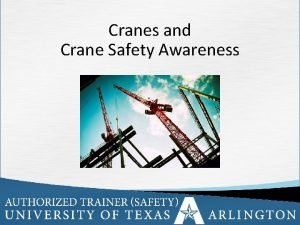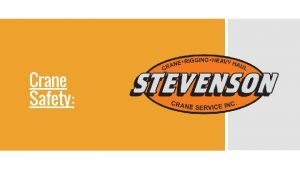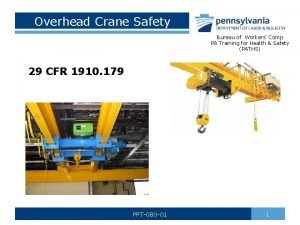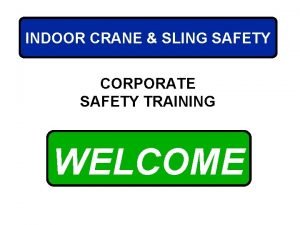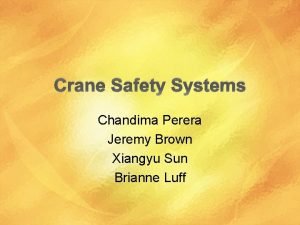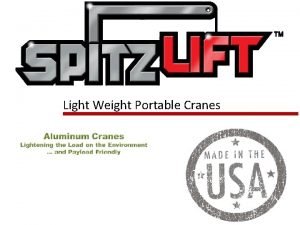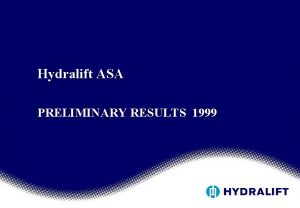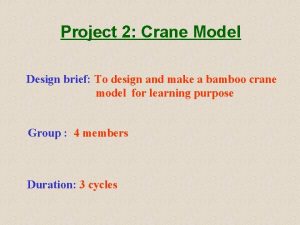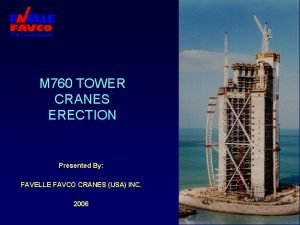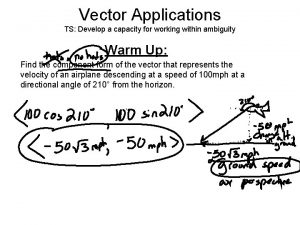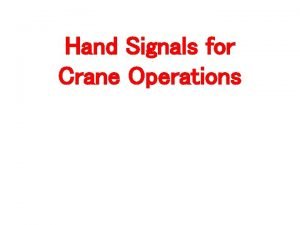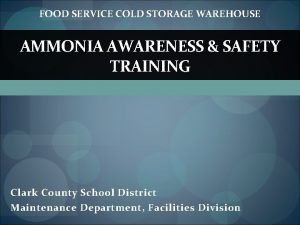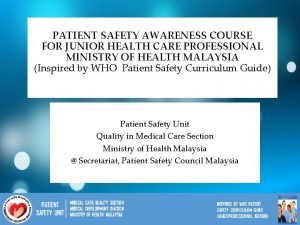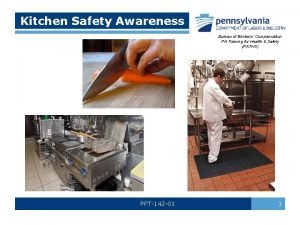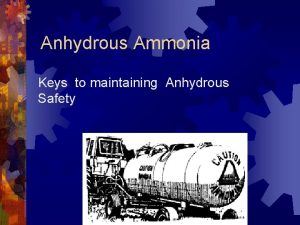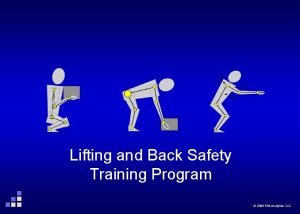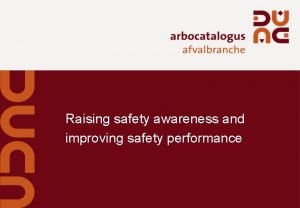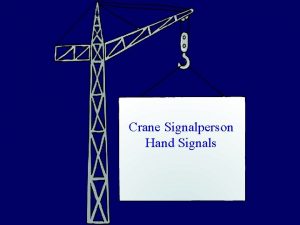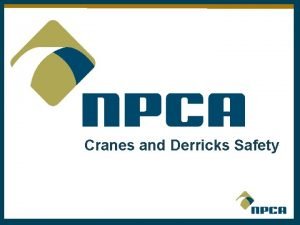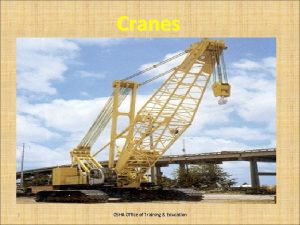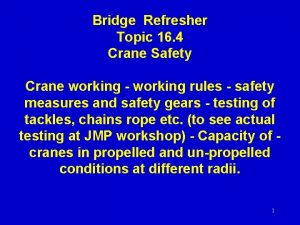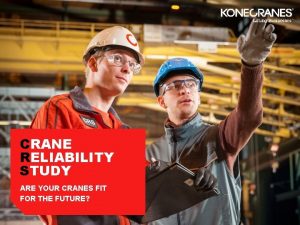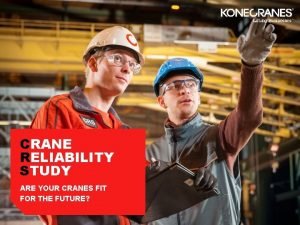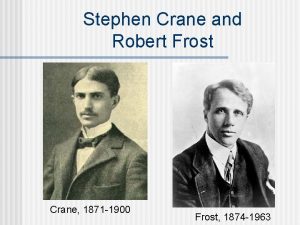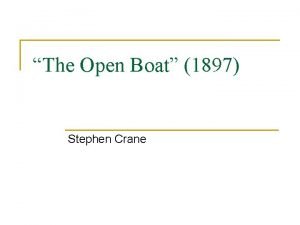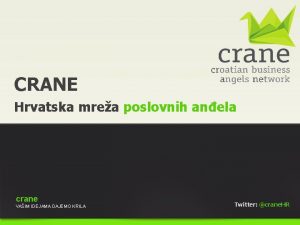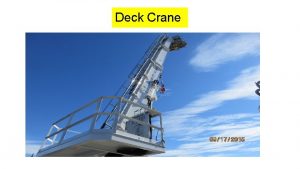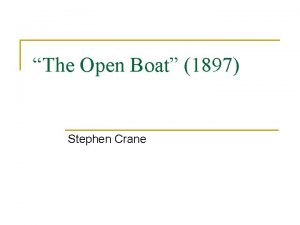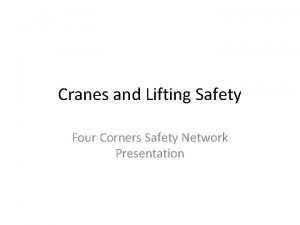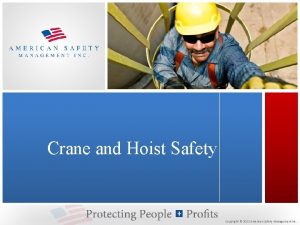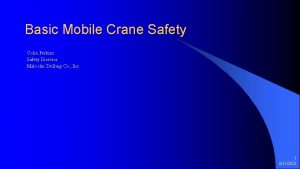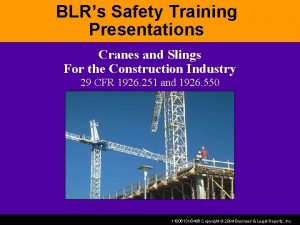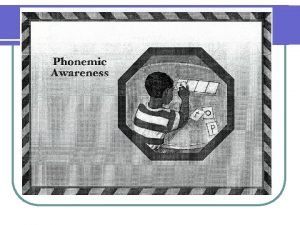Cranes and Crane Safety Awareness 1 The purpose


























































- Slides: 58

Cranes and Crane Safety Awareness 1

The purpose of this class is to provide you with an overall foundation of knowledge pertaining to Cranes and Crane Safety. Upon completion of this course, students will be able to identify types of cranes and their basic components, recognize hazards associated with cranes and understand safe operating practices based on guidelines established by OSHA. 2

Objectives • • Describe maintenance, inspection and certification requirements of cranes Understand load capacities, limits and lifting principles Describe safe assembly/disassembly activities Understand hand signals Describe hazards and most common causes of crane accidents Recognize types of cranes, basic components as well as rigging equipment Summarize OSHA standards pertaining to cranes Understand the roles and responsibilities of lifting personnel 3

Types of Cranes • • • Mobile Telescopic Crawler Lattice Side Lift All Terrain Truck Mounted Articulating Barge/Floating/Ship Railroad Aerial/Helicopter • • Overhead Traveling Wall Gantry Semi-Gantry Cantilever Straddle/Mobile Gantry Tower/Derrick Hammer Head Stiff-leg Derrick 4

Most Common Types of Cranes in Construction 5

Crawler Lattice 6 6

Wheel-Mounted Telescoping 7 7

Tower Crane 8 8

OSHA Crane Standards Construction - Cranes & Rigging • 1926. 1400 -1442 - Cranes Subpart CC • 1926. 251 - Rigging equipment for material handling Marine Terminals - Cargo Handling Gear and Equipment • 1917. 45 - Cranes and derricks (see also 1917. 50) • 1917. 50 - Certification of marine terminal material handling devices General Industry - 1910 Subpart N - Materials Handling and Storage • 1910. 179 - Overhead and gantry cranes • 1910. 180 - Crawler locomotive and truck cranes • 1910. 181 - Derricks • 1910. 183 - Helicopters • 1910. 184 - Slings 9

Wind Speed Incorporated by DOE Reference? DOE STANDARD, HOISTING AND RIGGING (Formerly Hoisting and Rigging Manual) DOE-STD-1090 -99 9. 5. 1 Conduct of Operator v. In the absence of crane manufacturer’s instructions regarding maximum wind speeds for operation, operations undertaken at wind speeds in excess of 25 mph should be evaluated by a qualified person to determine if the size, shape and weight of the load can be safely lifted. 15. 5. 2 Mobile Cranes/Boom Trucks 7. In the absence of crane manufacturer’s instructions regarding maximum wind speeds for operation, operations undertaken at wind speeds in excess of 25 mph should be evaluated by a qualified person to determine if the size, shape and weight of the load can be safely lifted. 4. 1 General 22. Personnel platforms should not be used in winds greater than 15 mph (25 km/h), electric storms, snow, ice, sleet, or other adverse weather conditions that could affect the safety of personnel. 10 10

Operator Qualification Certification 1427 & 1428 Should have taken effect November 10, 2014 but will now go into effect November 10, 2017. Option Description Portable Valid 1 Certification by an accredited crane operator testing organization Y 5 2 Qualification by an audited employer program Developed by an accredited crane operator testing organization or Approved by an auditor in accordance with CFR. N 5 3 Qualification by the U. S. military N Infinity 4 Licensing by a government entity N 5 or less 11 11

Feb. 7, 2014 Contact: Office of Communications Phone: 202 -693 -1999 OSHA issues proposed rule to extend compliance date for crane operator certification requirements WASHINGTON – The Occupational Safety and Health Administration today issued a proposed rule to extend the compliance date for the crane operator certification requirement by three years to Nov. 10, 2017. The proposal would also extend to the same date the existing phase-in requirement that employers ensure that their operators are qualified to operate the equipment. OSHA issued a final standard on requirements for cranes and derricks in construction work on Aug. 9, 2010. The standard requires crane operators on construction sites to meet one of four qualification/certification options by Nov. 10, 2014. After OSHA issued the standard, a number of parties raised concerns about the qualification/certification requirements. After conducting several public meetings, OSHA decided to extend the enforcement date so that the certification requirements do not take effect during potential rulemaking or cause disruption to the construction industry. Comments may submitted electronically at http: //www. regulations. gov, the Federal e-Rulemaking Portal or by facsimile or mail. See the Federal Register notice for submission details and additional information about this proposed rule. Comments must be submitted by March 12, 2014. OSHA held three stakeholder meetings on operator certification/qualification issues in April 2013 and posted detailed notes of the meetings at http: //www. osha. gov/cranes-derricks/stakeholders. html, a Web page devoted to the stakeholder meeting. A list of frequently asked questions are also posted on OSHA's Cranes and Derricks in Construction Web page to provide additional clarification and address some comments and concerns raised by stakeholders. Under the Occupational Safety and Health Act of 1970, employers are responsible for providing safe and healthful workplaces for their employees. OSHA's role is to ensure these conditions for America's working men and women by setting and enforcing standards, and providing training, education and assistance. For more information, visit http: //www. osha. gov. 12 12

Definitions • Crane – Consists of a rotating structure for lifting and lowering horizontally on rubber tires or crawler treads • Hoist – Used to lift and lower load • Boom – An inclined spar, strut, or other long member supporting the hoisting tackle • Boom stops – A device used to limit the angle of the boom at its highest position • Brake – To slow or stop motion by friction or power • Block – Sheaves or grooved pulleys in a frame with hook, eye and strap • Jib – Extension attached to the boom point to provide added boom length for lifting specified loads 13 13

Crane Parts 14 14

OSHA Competent Person vs. Qualified Person • This is in response to your memorandum of January 28, on the above subject. • 29 CFR 1926. 32(f) states: "Competent person" means on who is capable of identifying existing and predictable hazards in the surroundings or working conditions, which are unsanitary, hazardous, or dangerous to employees, and who has authorization to take prompt corrective measures to eliminate them. • 29 CFR 1926. 32(l) states: "Qualified" means one who, by possession of a recognized degree, certificate, or professional standing, or who by extensive knowledge, training and experience, has successfully demonstrated his ability to solve or resolve problems relating to the subject matter, the work, or the project. • These definitions provide that a competent person must have authority to take prompt measures to eliminate hazards at the work site and have the experience to be capable of identifying these hazards. This is the reason a competent person is required under inspection requirements in 29 CFR 1926. 650 and 29 CFR 1926. 651. • The definitions provide that a qualified person must have a recognized degree, certificate, etc. , or extensive experience and ability to solve the subject problems, at the worksite. This is the reason why 29 CFR 1926. 651(f) requires that supporting systems design shall be by a qualified person. There may be a requirement for more technical or engineering knowledge here. • Each excavation job as in any other case, must be evaluated as to the facts relating to the needs of a competent person, and qualified person. • The professional judgment of OSHA must come into play by using our construction regulations where they apply • Please advise if we can be of further assistance. 15 15

Qualified Operator Who needs to be certified or qualified? Any person engaged in a construction activity who is operating a crane covered by the new cranes and derricks rule, except: • Sideboom cranes • Derricks • Equipment with a rated hoisting/lifting capacity of 2, 000 pounds or less Operators of listed equipment must meet the criteria for minimum expertise described in the applicable section in subpart CC 1926. 1427 * A Certified Operator is currently recommended and expected to be required on November 10, 2017. 16

Qualified Operator When is a qualified rigger required? Employers must use qualified riggers during hoisting activities for assembly and disassembly work (1926. 1404(r)(1)). Additionally, qualified riggers are required whenever workers are within the fall zone and hooking, unhooking, or guiding a load, or doing the initial connection of a load to a component or structure (1926. 1425(c)). 17

Qualified Signal Person When is a signal person required? A signal person is required when: The point of operation is not in full view of the operator (1926. 1419(a)), the operator’s view is obstructed in the direction the equipment is traveling, or either the operator or the person handling the load determines that a signal person is needed because of site-specific safety concerns. 18

Subpart CC – Cranes and Derricks in Construction: Assembly/Disassembly Employers must comply with all manufacturer prohibitions regarding assembly and disassembly. The OSHA standard generally allows employers to choose between the manufacturer’s procedures or their own, any the most stringent must be followed. Employer procedures must be developed by a “qualified person” and must satisfy a number of specified requirements, such as providing adequate support and stability for all parts of the equipment, and positioning employees involved to minimize exposure to any unintended movement or collapse. 19

Assembly/Disassembly Responsibilities • The rule requires the work to be directed by an Assembly/Disassembly (A/D) director. The A/D director must meet the criteria for both a “competent person” and a “qualified person, ” which are terms defined in this rule, or must be a “competent person” assisted by a “qualified person. ” • The A/D director must understand the applicable procedures. • The A/D director must review the procedures immediately prior to beginning work unless he or she understands the procedures and has used them before for that equipment type and configuration. • The A/D director must ensure that each member of the crew understands his or her tasks, the hazards of the tasks, and any hazardous positions or locations to avoid. 20

Assembly/Disassembly Responsibilities (cont. ) • The A/D director must verify all capacities of any equipment used, including rigging, lifting lugs, etc. • The A/D director must also address hazards associated with the operation, including 12 specified areas of concern: • Site and ground conditions • Stability upon pin removal • Blocking material • Snagging • Proper location of blocking • Struck by counterweights • Verifying assist crane loads • Boom hoist brake failure • Boom & jib pick points • Loss of backward stability • Center of gravity • Wind speed and weather • Stability upon pin removal 21

A/D General Requirements • A crew member who moves out of the operator’s view to a location where the crew member could be injured by movement of the equipment (or load) MUST inform the operator before going to that location. The operator must not move the equipment until that crew member informs the operator that he or she has relocated to a safe position. • Employees must never be under the boom or jib when pins (or similar devices) are being removed, unless it is required by site constraints and the A/D director has implemented procedures that minimize the risk of unintended movement and the duration and extent of exposure under the boom. 22

A/D General Requirements (cont. ) • Component weights must be readily available for all components to be assembled. • All rigging must be done by a “qualified rigger. ” • Pins may not be removed during disassembly when the pendants are in tension. • Booms supported only by cantilevering must not exceed manufacturer limitations or RPE (Registered Professional Engineer) limitations, as applicable. • Component selection and equipment configuration that affects the capacity or safe operation of the equipment must be in accordance with manufacturer requirements and limits or RPE requirements and limits, as applicable. 23

A/D Outriggers and Stabilizers When outriggers or stabilizers are used or are necessary in light of the load to be handled and the operating radius: • Outriggers and stabilizers must be fully extended or, if permitted by manufacturer procedures, deployed is specified in the load chart. • Outriggers must be set to remove equipment weight from the wheels, except for locomotive cranes. • Outrigger floats, if used, must be attached to the outriggers; stabilizer floats, if used, must be attached to the stabilizers. • Each outrigger or stabilizer must be visible to the operator or to a signal person during extension and setting. • Outrigger and stabilizer blocking must be placed under the float/pad of the jack or, if there is no jack, under the outer bearing surface of the outrigger or stabilizer beam. Blocking must also be sufficient to sustain the loads and maintain stability and must be properly placed. 24

Crane Hazards • • • Contact with power lines Overturns Falls Mechanical failures Moving parts Improper load rating Excessive speeds No hand signals Inadequate inspection and maintenance 25 25

Crane Hazards (cont. ) • • Unguarded parts Unguarded swing radius Working too close to power lines Improper exhaust system Shattered windows No steps/guardrails walkways No boom angle indicator Not using outriggers 26 26

OSHA-Identified Crane Hazards OSHA's analysis identified the major causes of crane accidents to include: • • • Boom or crane contact with energized power lines (nearly 45% of the cases) Under the hook lifting device Overturned cranes Dropped loads Boom collapse Crushing by the counter weight Outrigger use Falls Rigging failures 27

Who is at Risk? • Operators • Persons at Crane Site 28 28

Power Lines The greatest risk for cranes is contacting power lines. 29 29

Stay clear from power lines at least 10 feet under 50 kv. Power Lines If the voltage of the power lines is unknown, stay at least 20 feet away or more and immediately contact your employer so that they may contact the utility provider to determine voltage of the power lines. Warning: Power lines can carry 50 kv, 250 kv, 350 kv, 500 kv or more. The higher the kv the greater the risk of arcing and employee injury and property damage. 30 30

Improper Load Improper loads or speeds can result in the tipping of the crane. 31 31

Improper Load 32 32

Improper Load 33 33

Guard Moving Parts Unguarded Chain Drive Guard moving parts such as gears or belts. 34 34

Swing Radius Stay out of the swing radius of the crane – make sure there are barrier guards showing swing radius. 35 35

Operator Visibility Broken Window Make sure broken windows or other obstructions do not prevent the operator from seeing. 36 36

Ladders Ladder Use ladders to get to the upper portion of the cab. 37 37

Guardrails Runways and steps need to have guardrails, handholds and slip resistant surfaces. 38 38

Planning Before Start-Up • Level the crane and ensure support surface is firm and able to support the load. • Contact power line owners and determine precautions. Know the location and voltage of overhead power lines. • Know the basic crane capacities, limitations, and job site restrictions, such as the location of power lines, unstable soil, or high winds. • Make other personnel aware of hoisting activities. • Barricade areas within swing radius. • Ensure proper maintenance and inspections. • Determine safe areas to store materials and place machinery. 39 39

Suspended Loads Don’t stand under suspended loads. 40 40

Common Reasons Accidents Occur • • • Instability – unsecured load, load capacity exceeded, or ground not level or too soft Lack of communication – the point of operation is a distance from the crane operator or not in full view of the operator Lack of training – inadequate maintenance or inspection 41 41

Competent Person The competent person must inspect all machinery and equipment prior to each use, and during use, to make sure it is in safe operating condition. If it needs fixing, take it out of service and don’t use it until it is fixed. Broken Track 42 42

Load Capacity - Speed - Warnings • Make sure the crane operator can see the: • Rated Load Capacities • Operating Speeds • Special Hazard Warning or Instruction Load Rating Chart 43 43

Boom Angle Indicator A boom angle indicator must be on the crane 44 44

Know the Weight of the Load • Refer to shipping ticket or other documentation • Ensure lift calculations are correct • Ensure load is within load chart rating for boom length and load radius of crane • Crane is rated by the maximum weight it will lift at a minimum radius and minimum boom length – the further from its centerpoint, the less it will lift 45 45

Load-Limiting Factors • • Not level Wind Side loads On its wheels Lifting over the side Use of extensions, jibs and other attachments Limits of wire rope, slings and lifting devices 46 46

Mobile Cranes – Lifting Principles • • Center of gravity Leverage Stability Structural integrity 47 47

Load Example – 30 Ton Crane • Will lift 60, 000 pounds at 10 feet from the center pin of the crane • Based on level surface, no wind, and outriggers fully extended • At 25 feet from the center pin with an 80 foot boom, the capacity is only 14, 950 pounds • At 74 feet from the center pin, the capacity is only 4, 800 pounds 48 48

Communication is Key 49

Hand Signals 50

Standard and Alternative Signals Hand signal charts must be either posted on the equipment or conspicuously posted in the vicinity of the hoisting operations. When using non-standard hand signals, the signal person, operator, and lift director (where there is one) must contact each other prior to the operation and agree on the non-standard hand signals that will be used. Hand signal charts must be either posted on the equipment or conspicuously posted in the vicinity of the hoisting operation. 51

Maintenance, Inspection and Crane Certification 52

Inspections - Each Shift A competent person must begin a visual inspection prior to each shift the equipment will be used. The inspection must consist of observation for apparent deficiencies. Taking apart equipment components and booming down is not required as part of this inspection unless the results of the visual inspection or trial operation indicate that further investigation is necessary. Determinations made in the inspection must be reassessed in light of observations made during operation. At a minimum the inspection must include all of the following: 53

• Control mechanisms for maladjustments interfering with properation. Control and drive mechanisms for apparent excessive wear of components and contamination by lubricants, water or other foreign matter. • Air, hydraulic, and other pressurized lines for deterioration or leakage, particularly those which flex in normal operation. • Hydraulic system for proper fluid level. • Hooks and latches for deformation, cracks, excessive wear, or damage such as from chemicals or heat. • Wire rope reeving for compliance with the manufacturer's specifications. • Wire rope, in accordance with § 1926. 1413(a). • Electrical apparatus for malfunctioning, signs of apparent excessive deterioration, dirt or moisture accumulation. 54

• Tires (when in use) for proper inflation and condition. • Ground conditions around the equipment for proper support, including ground settling under and around outriggers/stabilizers and supporting foundations, ground water accumulation, or similar conditions. • The equipment for level position within the tolerances specified by the equipment manufacturer's recommendations, both before each shift and after each move and setup. • Operator cab windows for significant cracks, breaks, or other deficiencies that would hamper the operator's view. • Rails, rail stops, rail clamps and supporting surfaces when the equipment has rail traveling. • Safety devices and operational aids for properation. 55

Monthly Inspections Each month the equipment is in service it must be inspected and records must be kept for at least 3 months. Annual/Comprehensive Inspections At least every 12 months the equipment must be inspected by a qualified person in accordance with 1926. 1412(f). 56

Review • Is anyone allowed to operate a crane? • MUST a crew member inform the operator before going to that location behind a crane or blind spot? • Is the greatest risk for cranes coming into contacting power lines? • When should crane be inspected? 57

Review • Is anyone allowed to operate a crane? No, only qualified operators. • MUST a crew member inform the operator before going to that location behind a crane or blind spot? Yes, always. • Is the greatest risk for cranes coming into contacting power lines? Yes, and being struck by a crane or falling load are also great risks. • When should crane be inspected? At the beginning of every shift, monthly and annually. 58
 Crane safety awareness
Crane safety awareness Cvs privacy awareness and hipaa privacy training
Cvs privacy awareness and hipaa privacy training Literary analysis task
Literary analysis task Sadako and the thousand paper cranes questions
Sadako and the thousand paper cranes questions Osha rules on lightning and cranes
Osha rules on lightning and cranes Sadako and the thousand paper cranes genre
Sadako and the thousand paper cranes genre Crane training ppt
Crane training ppt Slings safety training
Slings safety training Overhead crane inspection checklist doc
Overhead crane inspection checklist doc Crane safety systems
Crane safety systems Corner mount cranes
Corner mount cranes The cranes story
The cranes story Three cranes grove
Three cranes grove Hydralift offshore cranes
Hydralift offshore cranes Design brief for crane
Design brief for crane Favco cranes history
Favco cranes history The cranes shown in the figure are lifting an object
The cranes shown in the figure are lifting an object Use whip line signal
Use whip line signal Cold storage
Cold storage Patient safety council malaysia
Patient safety council malaysia Kitchen safety awareness
Kitchen safety awareness Rf safety awareness training answers
Rf safety awareness training answers Ammonia awareness safety policy
Ammonia awareness safety policy Back safety training
Back safety training Raising safety awareness
Raising safety awareness Hình ảnh bộ gõ cơ thể búng tay
Hình ảnh bộ gõ cơ thể búng tay Lp html
Lp html Bổ thể
Bổ thể Tỉ lệ cơ thể trẻ em
Tỉ lệ cơ thể trẻ em Chó sói
Chó sói Chụp tư thế worms-breton
Chụp tư thế worms-breton Alleluia hat len nguoi oi
Alleluia hat len nguoi oi Môn thể thao bắt đầu bằng chữ đua
Môn thể thao bắt đầu bằng chữ đua Thế nào là hệ số cao nhất
Thế nào là hệ số cao nhất Các châu lục và đại dương trên thế giới
Các châu lục và đại dương trên thế giới Công thức tính thế năng
Công thức tính thế năng Trời xanh đây là của chúng ta thể thơ
Trời xanh đây là của chúng ta thể thơ Mật thư tọa độ 5x5
Mật thư tọa độ 5x5 Làm thế nào để 102-1=99
Làm thế nào để 102-1=99 độ dài liên kết
độ dài liên kết Các châu lục và đại dương trên thế giới
Các châu lục và đại dương trên thế giới Thơ thất ngôn tứ tuyệt đường luật
Thơ thất ngôn tứ tuyệt đường luật Quá trình desamine hóa có thể tạo ra
Quá trình desamine hóa có thể tạo ra Một số thể thơ truyền thống
Một số thể thơ truyền thống Bàn tay mà dây bẩn
Bàn tay mà dây bẩn Vẽ hình chiếu vuông góc của vật thể sau
Vẽ hình chiếu vuông góc của vật thể sau Nguyên nhân của sự mỏi cơ sinh 8
Nguyên nhân của sự mỏi cơ sinh 8 đặc điểm cơ thể của người tối cổ
đặc điểm cơ thể của người tối cổ Thế nào là giọng cùng tên
Thế nào là giọng cùng tên Vẽ hình chiếu đứng bằng cạnh của vật thể
Vẽ hình chiếu đứng bằng cạnh của vật thể Phối cảnh
Phối cảnh Thẻ vin
Thẻ vin đại từ thay thế
đại từ thay thế điện thế nghỉ
điện thế nghỉ Tư thế ngồi viết
Tư thế ngồi viết Diễn thế sinh thái là
Diễn thế sinh thái là Dot
Dot Số nguyên tố là số gì
Số nguyên tố là số gì Tư thế ngồi viết
Tư thế ngồi viết
